Michael Walters
Notes from the peninsula
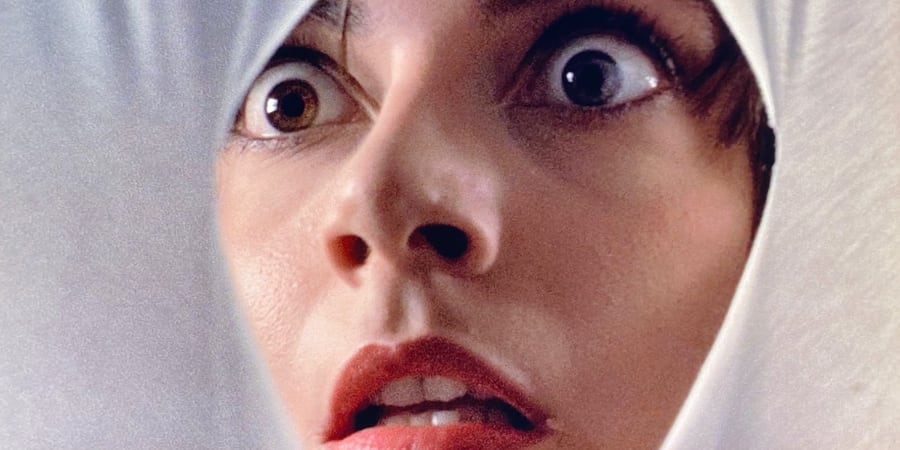
Tenebre
Director: Dario Argento
Release year: 1982
You see different things in a good piece of art as you get older. I wrote about Tenebre in October 2020 for the #31DaysofHorror challenge. I loved it then, and I love it now, but the protagonist is far less likeable than I remember, and the twists more surprising.
Back then, I wrote:
Tenebre is set in Rome, but we could be anywhere, because the story stays in hotel rooms, suburban streets and modernist buildings made of concrete and glass. There are artfully sculpted gardens of stone, water and trees. These locations lend themselves to the roving camera, and Argento likes to play the voyeuristic killer. The most famous scene has the camera drift slowly around the outside of a home, music blaring from a woman’s bedroom, focussing on the roof tiles, the walls, and the window slats, moving from room to room, as the killer takes two victims.
Thriller writer Peter Neal travels to Rome to market his latest book, Tenebrae (which means ‘darkness’), but he arrives to find a serial killer is mimicking in real life the murders in his book. The killer leaves notes under his hotel room door, and Neal gets drawn in to the killer’s game.
Argento knows films are inherently voyeuristic, and is aware of the criticism against him, and while the men die, the women do die in much more elaborate ways. He plays with our expectations, and has a protagonist who takes on the charges of misogyny directly. Giallo films usually have convoluted plots that lose me by the end, but this one makes sense. The set pieces are impressive, the story moves at a pace, the locations are fantastic, and the ending works — this is now one of my favourites.
I would add to this that Peter Neal isn’t interested in helping the police catch the killer at any point until he realises that it might make him look good as a crime writer. He’s another one of Argento’s male, egotistic, emotionally distant antiheroes, although some of the later plot twists make sense of that. There is also in the final scenes one of the all-time great reveals of the location of a killer.
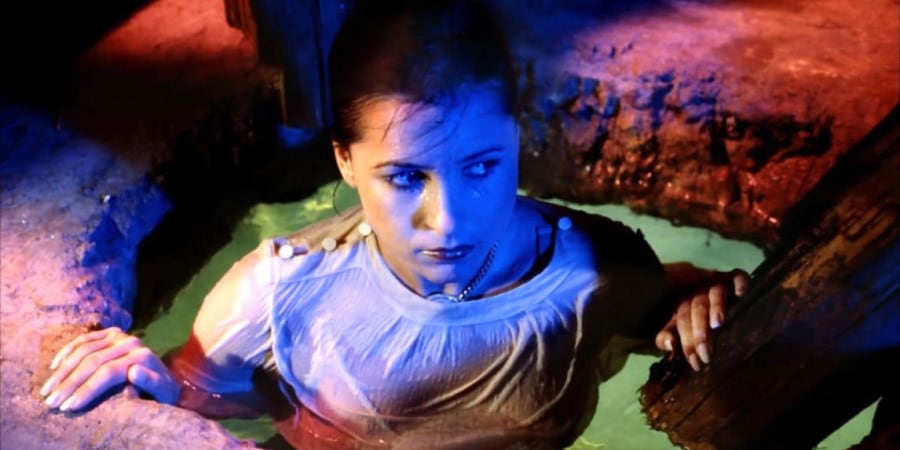
Inferno
Director: Dario Argento
Release year: 1980
If Suspiria was a step away from the narrative rigours of a whodunnit, Inferno is a giant leap, with four (four!) protagonists in two cities — but it starts with a woman, Rose, being sold a rare occult book called The Three Mothers.
Rose wonders if the glamorous but dilapidated New York apartment block she lives in is one of three built for three powerful witches, the others being in Rome and Freiberg (location of Suspiria). She writes to her brother David, a musicology student in Rome, but by the time he arrives she has gone missing, and he sets out to find her.
Inferno looks gorgeous, and it has the signature Argento set pieces, but it’s a big departure from his previous films. The score is less coherent, the events are even more surreal, and the pace is slower, with much time spent following people wandering through baroque hallways. It’s wondrous and frustrating.
The buildings are the real stars of the film. They’re filled with arcane objects, uncanny happenings, collapsed basements, spooky acoustics and levels between levels. The ending is fun, but the beautiful characters are one-dimensional, and the story is ponderous compared with everything that’s come before.
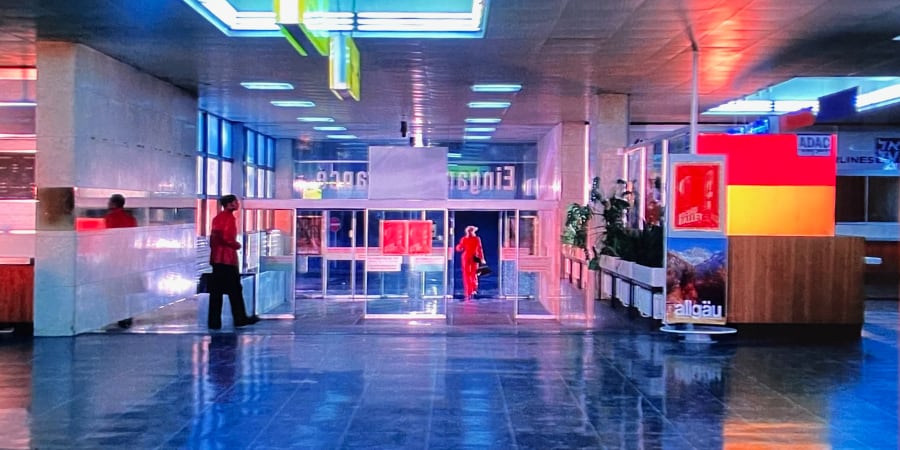
Suspiria
Director: Dario Argento
Release year: 1977
Suspiria is a vivid, colourful dream where death stalks us, out of sight but ever-present. Characters die in complicated and fantastical ways to Goblin’s driving mix of Moog synths, bells, whispered vocals and a drum beat for the ages. And it’s a film filled with strong women. The men are all ineffectual side characters.
Suzy Bannion, an American dance student, arrives on a stormy night at the Tanz Academy in Freiberg, Germany. Initially turned away, she passes a woman fleeing the building who ends up elaborately and gruesomely murdered. Suzy’s attempts to be independent at the Academy don’t last long, and she is quickly sucked into the sinister baroque world of a coven of witches.
The Goblin soundtrack is lauded as one of the greatest of any horror film, and it injects itself aggressively into the story, not just complementing it but as a multiplier, lifting the experience to giddy heights. Argento wanted to do something radical after the murder mysteries he’d become known for. The human killers from previous films are replaced with supernatural ones, and Argento’s artistic ambitions are given full rein, using architecture, lighting, music, camera lenses — whatever he could find to fulfil his vision. It’s completely captivating.
The characters are enjoyably odd, but Alida Valli is sensational as the amusingly-named Miss Tanner, the strict dance instructor who drives the ballet students on, barking orders with sadistic glee. Valli was the luminous Anna Schmidt in The Third Man, and also Louise, the complicit assistant to Dr. Génessier, in Georges Franju’s Eyes Without a Face. It’s a fun reminder of the variety of roles actors can find themselves taking, for many different reasons, over long careers.
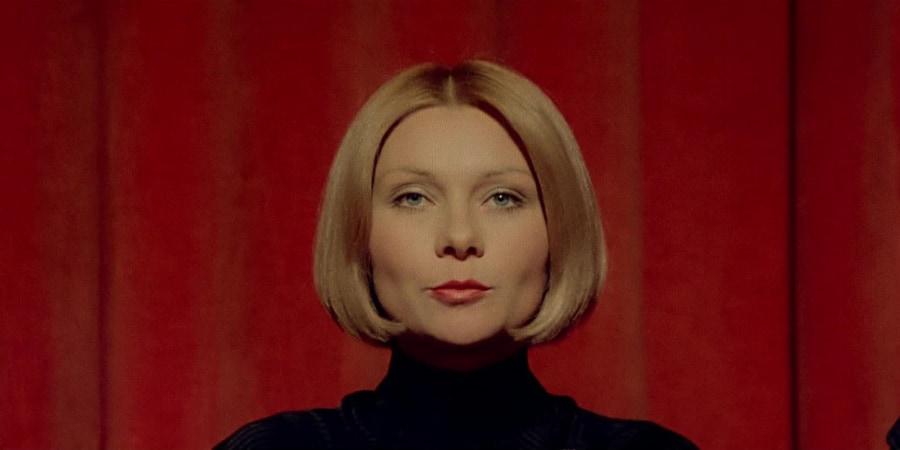
Deep Red
Director: Dario Argento
Release year: 1975
After making a couple of thrillers for television and a hard-to-find historical comedy that was a commercial flop, Argento returned to Giallo with a twisty, colourful, Goblin-scored mystery. Whenever the killer is about to strike, the bass jumps in and things get funky. It’s completely charming and made me smile every time.
David Hemmings plays pianist Marcus who sees the psychic living in the apartment below him murdered. He teams up with Gianna, a reporter, to investigate (played by Daria Nicolodi, who would become a creative and life partner to Argento, including mother to their daughter Asia), while also trying to look out for his troubled friend Carlo.
Marcus has more personality and humour than Michael Brandon’s Roberto in Four Flies on Grey Velvet, and his relationship with Gianna is played for laughs at times. There’s more comedy here than in Argento’s previous three Giallo films. Dolls are a recurring motif, even though the killer doesn’t have a particular connection with them — I suspect they just fitted with the aesthetic Argento was after.
There are (as you’d expect) beautifully staged set pieces where people die in gruesome ways. The killer’s unmasking works brilliantly. The tone shifts between horror, mystery, arthouse and comedy, and, along with the captivating performances, this unusual mix makes Deep Red exciting, strange and singular.
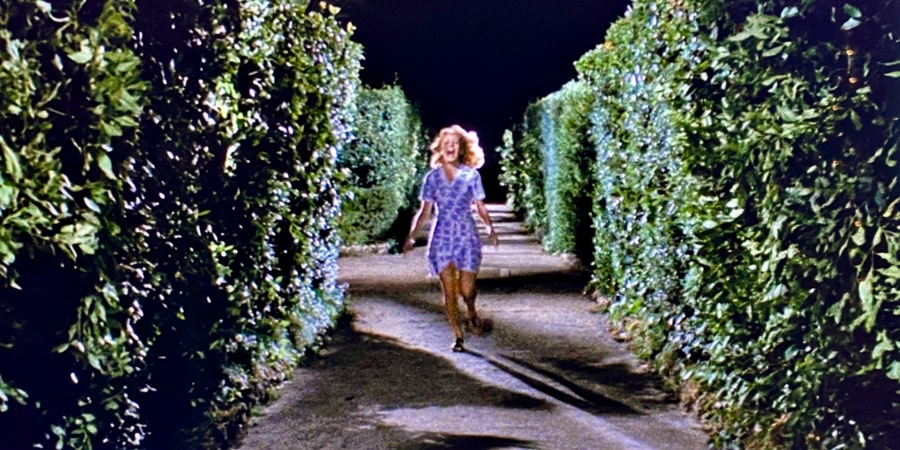
Director: Dario Argento
Release year: 1971
Roberto, an American drummer in a band recording in Milan, chases a man who has been following him and accidentally kills him. A masked figure takes photographs and begins to torment Roberto, breaking into his house and leaving behind evidence of the crime. When people begin to die, Roberto becomes increasingly paranoid, and he has to choose who to trust.
I enjoyed this. It’s common in slashers for the killer to wear a mask, but in gialli it’s more about black gloves, so it was fun to see the effectively creepy ventriliquist’s dummy mask here. It’s hard to warm to Roberto, who seems to be a bit of a dick, but Michael Brandon has amazing cheekbones, and the blankness of his character is made up for by the array of eccentrics around him. Argento likes to use gay characters, which is great, but they are often portrayed in stereotypical ways. The private detective Arrosio is the most sympathetic character in the film — funny, likeable and tragic.
Argento continues the playful camerawork of The Bird With the Crystal Plumage, zooming, swooping and changing focus so things are never dull. The standout set piece comes when the live-in maid tries to blackmail the killer, but instead is chased through a park, almost trapped between two walls of rock, before being sliced up within earshot of a couple trying to help. A busy children’s play area is suddenly empty, and a late afternoon cuts to night. Argento creates a nightmare his victims can’t escape.
The surreal, unexpected choices Argento makes throughout these first films make them far more interesting than more straightforward thrillers, and some of the jumps forwards and backwards reminded me of John Boorman’s Point Blank. The identity of the killer is a surprise — the way they are caught is completely ridiculous. However, the final slow motion shot of a car being crushed under a lorry is a mark of genius. And his first three films came out within two years. That’s a hot streak.
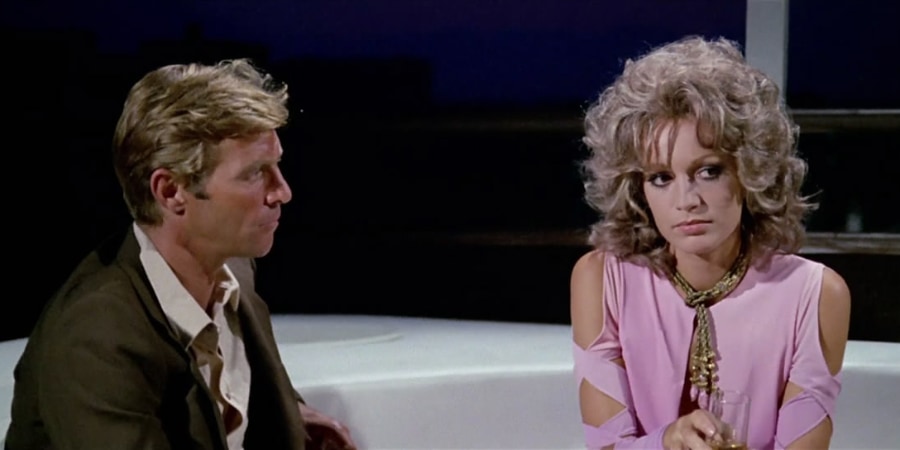
The Cat O’ Nine Tails
Director: Dario Argento
Release year: 1971
A solid Euro-thriller-giallo that lacks the flair of Argento’s debut, but still has enough ingenuity to keep things interesting. A blind ex-journalist overhears a conversation about blackmail outside his apartment. A newspaper reporter investigates a burglary in a nearby laboratory. As people at the lab start to die, the two men join forces to uncover the story, but industrial espionage is a dangerous game and the killer knows who’s on their tail.
Argento knows how to pick faces for his films — James Franciscus as reporter Carlo looks beautiful in every shot, stealing thunder even from the more seasoned Karl Malden as the blind puzzle-loving older man who the young girl in his care calls Cookie. And I love that Argento continued to include idiosyncratic secondary characters, like the burglar who always gets caught.
There’s roving first-person camera work, a handful of clever shots and a decent car chase, but it does feel like a consolidation of Argento’s skills as a director rather than a step up from The Bird with the Crystal Plumage. It’s slow in places, and the ending on the rooftops with the killer’s reveal felt clumsy.
Basing the story in a genetics lab, and making the industrial espionage secret to be about a genetic marker for violence and murder, makes this a distant cousin of David Cronenberg’s more perverse surgical labs across the Atlantic a few years later. In ‘Bird’, the killer has an untreated trauma that causes psychosis; in ‘Cat’, the killer is protecting themselves from their own family’s business. What will be the killer’s motivation in the final part of Argento’s trilogy of animals?

Director: Dario Argento
Release year: 1970
In one interview in Panico (2024), a documentary about Dario Argento’s life in films, Argento describes himself as being of two halves — the contented person at home, and the person who is compelled to investigate the darkness inside himself through filmmaking. When in that mode, he is completely focussed on making real the visions in his mind, and it’s clear from the interviews that, especially in the first half of his career, he had a controlling and cold edge alongside his energy and passion.
This made me want to go back to the beginning, and The Bird with the Crystal Plumage is a fascinating opening salvo. American writer Sam is on holiday in Rome with his girlfriend, Julia, to overcome his writer’s block. He witnesses an attack in an art gallery and gets pulled in to help investigate the case by Inspector Morosini. Other women have been attacked and killed across Rome, and the serial killer threatens Sam to not get involved, but Morosini has Sam’s passport, and Sam believes he’s getting ever closer to the identity of the killer.
Tony Musante, Suzy Kendall and Enrico Salerno make a charismatic trio. Argento makes the camera his plaything, and the cinematic flourishes are due in no small part to the editing by Franco Fraticelli who became a collaborator for the next two decades. The world of the film is vibrant and odd, with threatening pieces of art, colourful Roman characters, and the fetishistic use of gloves, knives and (of course) voyeurism.
It’s not a perfect film. The dialogue can be distractingly banal, especially at the start when the initially poor dubbing makes everything worse, and the pacing is occasionally poor, but the continual visual style, the ingenuity with the hand-held camera, and the series of imaginative set pieces make you forget the bad as soon as the film ends.
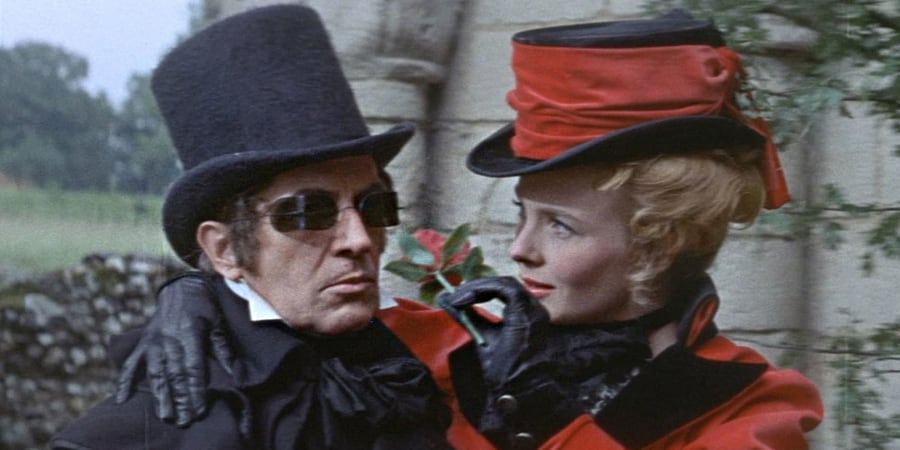
Ligeia
Ligeia, by Edgar Allan Poe, is a six-thousand-word hallucinatory tale about an intense marriage that survives beyond death. The narrator is looking back, remembering his wife, Ligeia, who he idolised. When she dies unexpectedly, he moves to an abbey in Cornwall, decorates it opulently with Egyptian artifacts, and marries again, this time to the ‘fair-haired and blue-eyed Lady Rowena Trevanion, of Tremaine’.
Still obsessed with the black-haired, dead Ligeia, who he describes in tortuous detail, he takes opium to numb his grief, and treats Rowena terribly. After a month of marriage, Rowena falls suddenly ill, recovers, but falls ill again, and in opium-infused memories he sees a ghostly form put poison in her drink. Ligeia was sure that she could avoid death through the force of her own will, and the narrator believes her ghost comes back in Rowena’s body.
Ligeia was first published in 1838, in American Museum magazine, but was revised extensively in future publications. Critics liked it, George Bernard Shaw loved it, and some thought it to be a satire of the gothic fiction of its day. It’s written in an intense, overwrought style, common at the time, and it may well have been deliberately so to make fun of it even in 1838. As the first Poe story I’ve read, it’s hard for me to judge, and it makes me wonder what the others are like.
The narrator’s love for Ligeia is like a son with his mother. It’s unnaturally intense in adulthood, and in the story’s language there are hints of foul play in her death. He paints her as an academic enchantress, which must have been as terrifying as it was seemingly satisfying. It makes me wonder if the narrator killed Ligeia — and then killed his second wife too.
In Archetypal Projection in “Ligeia”: A Post-Jungian Reading, Joseph Andriano sees the narrator as charmed by an anima daemon, a shadow feminine character, who stays alive in him and comes back through his wife-imposter. He ‘kills his mother’, only to find her again in the next woman he marries. Another analysis of Ligeia observes the sex hidden beneath the Victorian veil, and suggest Poe is a ‘genteel pornographer’.
After buying the Blu-ray player (!), I watched Roger Corman’s The Tomb of Ligeia (1964), which looked beautiful. Vincent Price acts his socks off as Verden Fell, the name given to the narrator by screenwriter Robert Towne. Fell buries his wife, Ligeia, in the graveyard at his abbey, but his grief is interrupted by Elizabeth Shepherd as a persistent, dynamic Lady Rowena, attracted to the abrasive, unpleasant Fell. The story doesn’t have much overlap with Poe’s original, focussing on mesmerism rather than opium or witchcraft, and it ends with the standard sixties gothic trope of an old building burning down, but it’s charming, with excellent dialogue, and pleasingly committed performances for a tightly-budgeted (aka cheap) Corman film. Lots of cats are thrown around. Shepherd has a dual role, which reminds me of Barbara Steele in Black Sunday (1963). I wonder if Corman was influenced by Mario Bava.
I could go in several directions from here — more Poe short stories, more Poe adaptations by Corman (he made eight between 1960—64, his ‘Poe cycle’), more Cornish horror shorts, or coastal horror stories in general… having a small project this week worked well.
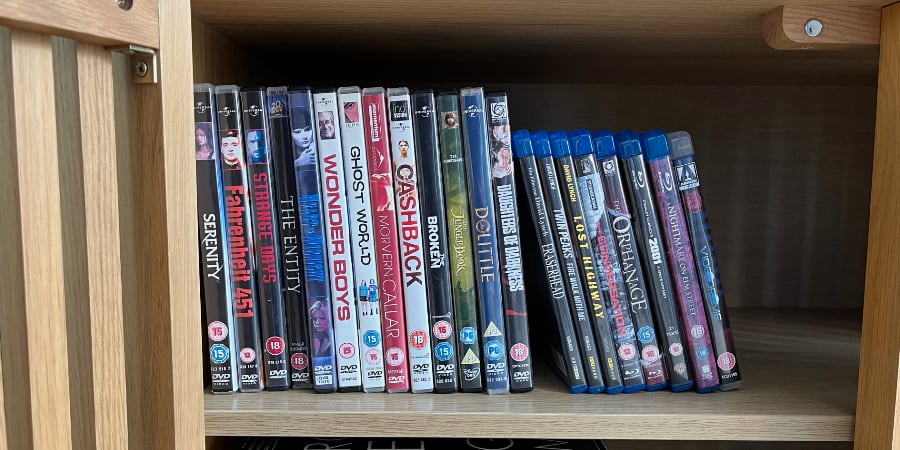
Physical media
Continuing my interest in how fiction and films work together, I picked up Cornish Horrors: Tales from the Land’s End, part of the British Library’s Tales of the Weird series, a collection I’ve owned for a few years and never read, and when the intro to the first story, Ligeia, by Edgar Allan Poe, mentioned there was a 1964 film with Vincent Price, I saw a project in the making.
Corman’s version, The Tomb of Ligeia, was written by Robert Towne and Paul Mayersberg. It has an Arrow Blu-ray with lots of extras for the curious, but it’s not available on the Arrow Video streaming service, and it’s not online anywhere else either. Amazon helpfully pointed out a well-reviewed six-disc collection of Corman/Poe films, all starring Vincent Price, and all films that I didn’t know, for £30.
Now, over the years I’ve built an extensive collection of digital films, but when I was keen to watch something specific and it wasn’t available online, I bought discs instead. This was when I had an old PS3, which died died about five years ago. I’ve been meaning to get a replacement player for a while, but I go in circles over the point of buying physical media. Underneath my TV I have a DVD of Heart of Midnight (with a young Jennifer Jason Leigh), and Blu-rays of Eraserhead and Daughters of Darkness. None of these are available online.
I committed. I bought a 4K Blu-ray player — a Panasonic DP-UB450EB, not a PS5, as tempting as that was. I don’t want to play video games, and the disc player is pretty basic compared to the standalone machines. I don’t want to become a physical media obsessive (take note, uc); I do want to watch the more obscure films I’m curious about.
It all arrives tomorrow. I’m going to read the short story this afternoon (I haven’t even read the story, and I’ve bought a Blu-ray player!), then watch the film this week and see what shakes out. I’m thinking about gothic stories on coastlines for my work-in-progress. That’s where all this started.
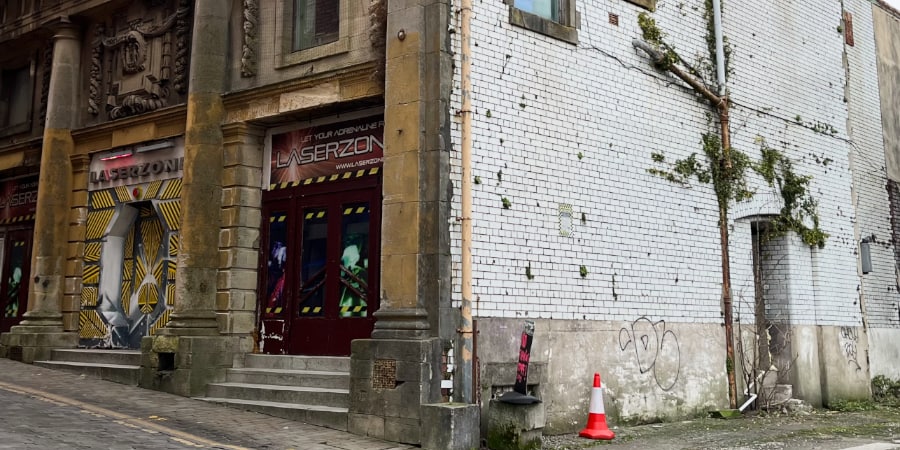
Nostalgia
- 07.01: PRISCILLA (2023), dir. Sofia Coppola (C)
- 10.01: OLD HENRY (2021), dir. Potsy Ponciroli
I’m in Wales at short notice because Dad’s been admitted into hospital. The co-morbidities have gathered and decided to strike. He’s in bad shape. I can see him at 2pm and 6pm, and around these visiting times I’m looking for peaceful, distracting activities. This morning I went to Swansea for a coffee and took photographs of the buildings around the castle. Then I drove to Mumbles and walked up to the house I used to rent an attic room in before dropping to the seafront. As ever, ghosts and shadows walk with me in the absence of real people. Swansea is a lonely comfort.
Nostalgia turns quickly to poison once the immediate comfort has passed. Sofia Coppola creates an exquisite rendition of fifties life in Priscilla that is without dirt or dust—no unwashed cars or clothes here—designed to pull you in and keep you there. The performances are similarly immaculate, but the problem with the perfection of nostalgia is that it lacks soul. We want to be back somewhere that never existed. This isn’t Elvis or Priscilla as they were, it’s a story told through sensual details, costumes, sounds, imagined dialogue. It’s fine. The best use of nostalgia is to let it show what is missing now. From that you can create something new.
Artists, especially filmmakers and writers, can recreate the past in their work, and nostalgia can be part of that creative energy but doesn’t have to be. There’s little nostalgia in Old Henry. It’s set in the rural midwest, in 1906, where the Wild West overlaps in history with the start of modern times. This 1906 is dirty and brutal. A grizzled farmer takes in an injured man carrying a satchel full of money, but the chasing gang catch up with him, and a standoff ensues. The farmer’s son wants to fight, but we learn the farmer has a violent past of his own. Old Henry is as exquisitely crafted as Priscilla, but more realistic, with a father-son relationship that sucked me in, and a glorious twist going into the final act that made me laugh out loud. Tim Blake Nelson is astonishing.
Note to self: acknowledge what you need and make something new to satisfy that need.

Fidelity
- 01.01: SILENT NIGHT (2021), dir. Camille Griffin
- 02.01: Assembly, Natasha Brown (01.01)
- 06.01: Infidelities, Kirsty Gunn (02.01)
I’ve deleted my Patreon creator’s account, which was beginning to feel like I was cheating on my website (or the other way around, I’m not sure). Two places for almost the same words, except on Patreon I was receiving money to support me as an artist, and here it’s always been the spirit of blogging on the “free Web”. I haven’t reconciled those two things. A writer needs to pay the bills, and every story (or blog post, or skeet) is a gift. It’s straightforward economically but not psychologically.
One of the things I did on Patreon to “add value” was post a list of films and books I’d read at the end of each month, in the spirit of Steven Soderbergh’s SEEN, READ lists. I published my 2023 Seen, Read list on New Year’s Day. People are fascinated by what famous directors are engaged with while they make their films, so there’s a ta-da moment to the yearly list, but nobody gives a shit about my annual list. I wondered if I could use the concept to think aloud about what I’m watching and reading in relation to what I’m writing. I’m going to give it a go in January. And keep the posts short.
I found Silent Night to be tonally jarring, but that might be the point—a broad comedy (Keira Knightley is hilarious) with vague references to a coming apocalypse that turns hard in the final act into the existential horrors of climate change. It mocks the rich mercilessly and brings a reckoning for their denial of feelings, suffering, and reality. Saltburn did a similar thing in a different way.
There is a far more subtle takedown of the rich in Assembly. A black woman working at a global bank in the City feels the relentless pressure to conform to the expectations of a colonialism-created patriarchy. The title refers to the school assemblies she presents at, and the way she experiences her life as a Frankenstein monster of things other people need her to be. Her boyfriend comes from a rich family. She learns she has cancer and hides it from him. It’s fierce! And it’s the shortest novel (cough) I’ve read at 100 pages.
Infidelities is a collection of short stories. The final story, Infidelity, was the most interesting, in that it digs into the mechanics of writing, playing with all the little decisions writers make and what it means to write something that feels right. It takes care and courage to write a story that has integrity—a useful reminder of what’s at stake.

Seen, Read: 2023
- FILMS IN ALL CAPS (C if in cinema)
- Books, by author, on end date (with start date)
Here’s my list for 2023:
- 01.01 THE CONVERSATION
- 10.01 JOAN DIDION: THE CENTER WILL NOT HOLD
- 12.01 THE VELVET UNDERGROUND
- 14.01 THE BATMAN
- 19.01 LAST YEAR AT MARIENBAD
- 21.01 THE MENU
- 25.01 BLUE THUNDER
- 29.01 The Day of the Triffids, John Wyndham (18.01)
- 30.01 THE CHINA SYNDROME
- 01.02 HARRY DEAN STANTON: PARTLY FICTION
- 02.02 M3GAN (C)
- 04.02 AFTERSUN
- 06.02 SR.
- 09.02 SUMMER OF SOUL
- 11.02 WORLD WAR Z; DIE HARD
- 14.02 SIBYL
- 17.02 BULLET TRAIN
- 18.02 JURASSIC WORLD: DOMINION
- 23.02 FIRE OF LOVE; BARBARIAN
- 26.02 JADE
- 27.02 The Drowned World, J.G. Ballard (02.02)
- 02.03 ORCHESTRATOR OF STORMS: THE FANTASTIQUE WORLD OF JEAN ROLLIN
- 04.03 STARSHIP TROOPERS; THE GAME
- 05.03 THE SWIMMER (1968)
- 07.03 8½
- 10.03 OFFICIAL COMPETITION
- 11.03 WE’RE ALL GOING TO THE WORLD’S FAIR
- 15.03 SPASMO
- 19.03 EVERYTHING EVERYWHERE ALL AT ONCE
- 20.03 Weather, Jenny Offil (03.03)
- 24.03 THE HAUNTING OF MARGAM CASTLE
- 24.03 GLASTONBURY THE MOVIE IN FLASHBACK
- 26.03 THE LAIR
- 26.03 Hour of the Star, Clarice Lispector (22.03)
- 27.03 SAVAGE DAWN
- 29.03 NIGHTMARE AT NOON
- 01.04 THE MATRIX RESURRECTIONS
- 03.04 BARTON FINK
- 09.04 KING COHEN: THE WILD WORLD OF FILMMAKER LARRY COHEN
- 10.04 JOHN WICK: CHAPTER 4 (C)
- 11.04 A Study in Scarlet, Arthur Conan Doyle (23.03)
- 12.04 LA NOTTE
- 15.04 SAINT JACK
- 16.04 RENFIELD (C)
- 17.04 MOONAGE DAYDREAM
- 18.04 PIECES
- 29.04 STUTZ; TREMORS 2: AFTERSHOCKS
- 01.05 JURASSIC PARK
- 06.05 EASY RIDERS, RAGING BULLS
- 07.05 DUNE (2021)
- 12.05 BATMAN
- 13.05 BATMAN RETURNS
- 16.05 THE RELIC
- 17.05 Play It As It Lays, Joan Didion (15.05)
- 19.05 THE EQUALIZER
- 20.05 THE EQUALIZER 2
- 21.05 HEAT (C)
- 28.05 FIGHT CLUB (C)
- 29.05 LETHAL WEAPON; Dreams of Sleep, Josephine Humphreys (23.05)
- 02.06 SPIDER-MAN: ACROSS THE SPIDER-VERSE (C)
- 03.06 HAYWIRE
- 04.06 DÉJÀ VU
- 10.06 CONFESS, FLETCH; PLUNGING ON ALONE: MONTE HELLMAN’S LIFE IN A DAY; The Bloater, Rosemary Tonks (07.06)
- 11.06 THE ROCKY HORROR PICTURE SHOW (C)
- 12.06 THE OUTFIT
- 15.06 No One is Talking About This, Patricia Lockwood (14.06)
- 17.06 CLUE
- 17.06 THE FLASH (C)
- 23.06 Scent of a City, Aki Gibbons (18.06)
- 24.06 ASTEROID CITY (C); The Midwich Cuckoos, John Wyndham (21.06)
- 25.06 THE ADVENTURES OF PRISCILLA, QUEEN OF THE DESERT (C)
- 30.06 EXTRACTION
- 01.07 EXTRACTION 2
- 06.07 ASTEROID CITY (C)
- 08.07 ELEMENTAL (C)
- 09.07 INDIANA JONES AND THE DIAL OF DESTINY (C)
- 11.07 MISSION: IMPOSSIBLE – DEAD RECKONING PART ONE (C)
- 15.07 THE FUGITIVE
- 16.07 THE BIG LEBOWSKI (C)
- 20.07 MISSION: IMPOSSIBLE – DEAD RECKONING PART ONE (C)
- 22.07 BARBIE (C)
- 23.07 BERGMAN ISLAND; What About Men, Caitlin Moran (23.07)
- 24.07 LA DOLCE VITA
- 30.07 SOME LIKE IT HOT (C)
- 04.08 JAWS
- 06.08 MEG 2: THE TRENCH (C)
- 12.08 DUNGEONS & DRAGONS: HONOR AMONG THIEVES
- 14.08 ONE FINE MORNING
- 15.08 DEEP BLUE SEA 3
- 16.08 FATHER OF MY CHILDREN; SHARKSPLOITATION
- 18.08 AFTER YANG
- 19.08 [REC] 3: GENESIS; OPPENHEIMER (C); Eastmouth and Other Stories, Alison Moore (02.08)
- 21.08 [REC] 4: APOCALYPSE
- 25.08 GENTLEMEN PREFER BLONDES; THEATER CAMP (C)
- 27.08 Losing Track, Imogen Reid (25.08)
- 03.09 THE EQUALIZER 3 (C)
- 04.09 Mrs Dalloway, Virginia Woolf
- 05.09 SMILE
- 09.09 PAST LIVES (C)
- 10.09 INGLOURIOUS BASTERDS (C)
- 11.09 The Memory Police, Yōko Ogawa
- 13.09 AN IMPOSSIBLE PROJECT
- 16.09 A HAUNTING IN VENICE (C)
- 17.09 THE CURSED
- 18.09 THE BROKEN
- 19.09 DIARY OF THE DEAD
- 20.09 SURVIVAL OF THE DEAD
- 23.09 EYE IN THE LABYRINTH; STRIP NUDE FOR YOUR KILLER
- 24.09 THE EXORCIST III; THE DEVIL WEARS PRADA (C)
- 25.09 THE PALE BLUE EYE
- 30.09 65
- 02.10 RE-ANIMATOR
- 04.10 THERE’S NOTHING OUT THERE
- 06.10 CASTLE FREAK
- 07.10 SCREAM
- 07.10 SCREAM VI
- 08.10 THE CREATOR (C)
- 09.10 DEATH SHIP
- 10.10 SLUGS
- 11.10 THE LAIR OF THE WHITE WORM
- 12.10 CRIMES OF THE FUTURE
- 14.10 DON’T LOOK NOW (C)
- 15.10 MESSIAH OF EVIL
- 17.10 INFINITY POOL
- 18.10 LIFEFORCE
- 18.10 THE RETURN OF THE LIVING DEAD
- 20.10 DUEL
- 20.10 EVIL DEAD II
- 21.10 INVADERS FROM MARS
- 22.10 YOU’RE NEXT
- 24.10 CLOVERFIELD
- 27.09 Sea State, Tabitha Lasley (23.09)
- 28.10 THE KILLER (C)
- 29.10 ENEMY
- 31.10 HALLOWEEN; Brother of the More Famous Jack, Barbara Trapido (27.09)
- 04.11 THE SOUVENIR: PART II
- 11.11 THE MARVELS (C)
- 12.11 DREAM SCENARIO (C)
- 17.11 SALTBURN (C)
- 19.11 THE HUNGER GAMES: THE BALLAD OF SONGBIRDS & SNAKES (C)
- 27.11 THE KILLER
- 28.11 6 UNDERGROUND
- 29.11 LAKE PLACID
- 30.11 MICHAEL CLAYTON
- 03.12 LOVE ACTUALLY (C)
- 09.12 SIBERIA
- 10.12 THE HOLIDAY (C)
- 11.12 SHOWING UP
- 15.12 WONKA (C)
- 16.12 Children of Paradise, Camilla Grudova (15.12)
- 24.12 PUSS IN BOOTS: THE LAST WISH
- 25.12 SHERLOCK HOLMES (2009)
- 26.12 FERRARI (C)
- 29.12 My Phantoms, Gwendoline Riley (27.12)
- 31.12 RETURN TO SEOUL
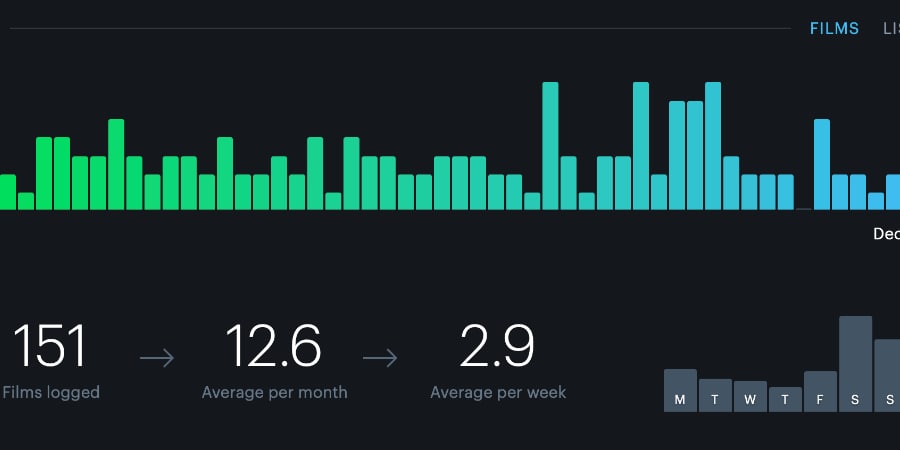
Best film discoveries and fiction of 2023
Using my Letterboxd stats, I have an excellent view of every film I’ve watched this year, as well as a score for each. (In hindsight, I disagree with some scores, but that’s the risk when you give a rating in the heat of the moment.)
I watched 148 films, three of them twice (Asteroid City, The Killer, Mission Impossible: Dead Reckoning Part 1). I gave thirty films 5 stars and only two films 1 star (Deep Blue Sea 3, The Haunting of Margam Castle). I skew high because I choose films I’m probably going to like. I also gave 30 films a heart, some of which were not 5-star films (Bergman Island, An Impossible Project, Lake Placid, The Lair of the White Worm, Pieces, We’re All Going to the World’s Fair, The Game)
Anyway, here are my ten favourite film discoveries of 2023:
- Asteroid City
- The Killer
- The Souvenir: Part 2
- The Menu
- Aftersun
- Enemy
- The Relic
- Last Year at Marianbad
- Moonage Daydream
- Spider-Man: Across the Spider-Verse
I’m surprised how many of those are films that came out in 2023, considering the range of films I’ve seen this year.
And with less sexy stats available, my ten favourite books (in order of reading, not preference):
- The Day of the Triffids, John Wyndham
- Play It As It Lays, Joan Didion
- Dreams of Sleep, Josephine Humphreys
- The Bloater, Rosemary Tonks
- Scent of a City, Aki Gibbons
- Eastmouth and Other Stories, Alison Moore
- Mrs Dalloway, Virginia Woolf
- Brother of the More Famous Jack, Barbara Trapido
- Children of Paradise, Camilla Grudova
- My Phantoms, Gwendoline Riley
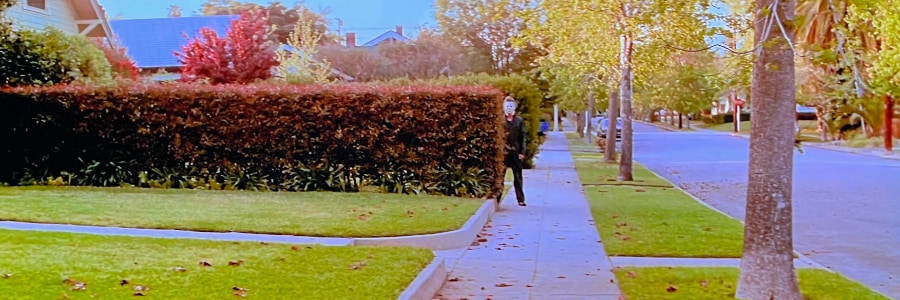
Halloween (1978)
Director: John Carpenter
In Haddonfield, on Halloween night 1963, the young Michael Myers, after watching his sister make out with her boyfriend, stabs her to death with a kitchen knife and is locked away. Fifteen years later he escapes and returns to his empty family home. His doctor, Loomis, gives chase, but Myers has already taken an interest in a young high school student, Laurie Strode, and her friends Lynda and Annie. He steals a mask, a kitchen knife and some rope, and sets about a night of multiple murders.
And so I return to where this horror project began, seven years ago, in October 2016, when I decided to watch a few horror films to get me in the seasonal mood. It has a purity that other slashers don’t have — the crisp cinematography, Laurie’s naive, nerdy charm, the simple (perfect) motif of the score. I can’t fully explain it. It’s like Alien in that way. It gets everything right first time. All the copycats and sequels (and requels) can’t recapture the original’s magic.

Enemy (2013)
Director: Denis Villeneuve
This is my favourite discovery of the month. It doesn’t give up its meaning easily, which I respect, and the performances are engrossing. Barely ninety minutes, looks beautiful, has a startling final image, and I’m still thinking about it a day later. The opening scene—a group of well-dressed men, including Adam (or is it Anthony?), watch a woman in a club masturbate before moving to impale a live tarantula on one of her heels—creates a tone of background dread that comes to astonishing fruition in the final act.
Adam is a professor at a university in Toronto, living a repetitive existence in a bland, half-empty apartment, with a girlfriend who comes and goes. He lectures on dictatorships and the different ways they control populations. A colleague at his office suggests a film, and out of boredom Adam rents it. He notices one of the extras, Anthony Claire, looks just like him, so he decides to track him down, but Anthony doesn’t like the unexpected attention.
Adam, girlfriend Mary, Anthony, and his wife Helen, dance around each other as the fantastical fact of these two men’s identical bodies with different personalities plays out. Every scene has something in it, whether a background object or a line of dialogue, that suggests something about the mystery, but nothing prepares you for the final beat and Adam’s ambiguous reaction.
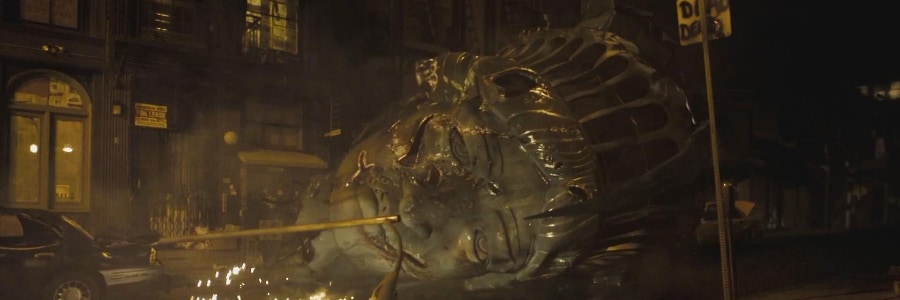
Cloverfield (2008)
Director: Matt Reeves
Monster movies, or at least big monsters in movies, are about destruction, usually of cities, and about how small we are in the face of them. They’re similar to disaster movies in that way — hurricanes, earthquakes, tidal waves and tornadoes all make us feel insignificant and powerless, which has certain psychological comforts.
Cloverfield is the name given by the US military to a catastrophic alien event in Manhattan, and from the beginning we know the found footage we’re watching is classified. Rob and Beth have broken up because Rob has a new job in (amusingly) Tokyo. They meet again at his leaving party in a Manhattan high rise with their new partners, and just as we discover they might get together, explosions rock the city.
I saw this in the cinema when it came out, and I remember feeling frustrated at the shaky camera and sparse glimpses of the monster. Actually, you see quite a lot of the monster, and I wonder if I was overwhelmed on the big screen, or if I was comparing it to films like Godzilla or King Kong, where the creatures are very much on display. You have to really focus on what’s happening if you want to see the alien here. I could have done with less twenty-something relationship drama in the first thirty minutes, but it does give Rob emotional stakes to go back to the collapsing building for the finale. Not that that does him any good.
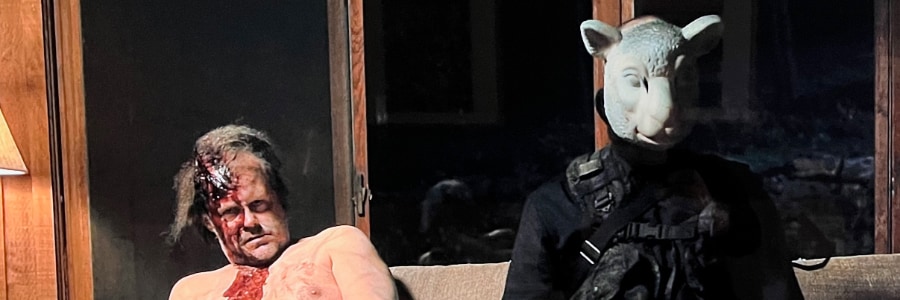
You're Next (2011)
Director: Adam Wingard
The super-rich Davisons are having a get-together for the first time in years at a remote family-owned mansion. Patriarch Paul has his favourites, but none of his children get along. One of his sons, Felix, brings girlfriend Erin to meet everyone for the first time. Nobody knows that a gang of masked intruders have just killed a couple in a nearby house and it looks like the Davison family are next.
I enjoyed this, but it is bleak, mainly because everyone apart from Erin, our heroine, is an awful person. Her secret ability to adapt and survive in the face of attack is surprising, then funny, and eventually unnerving as she brutally dispatches people with a variety of unlikely weapons.
It has notes from Home Alone, but I was more struck by its impact on films that came later, like Ready or Not, and 2022’s version of Scream. Is this the beginning of the trend towards final girls becoming as violent as their attackers?
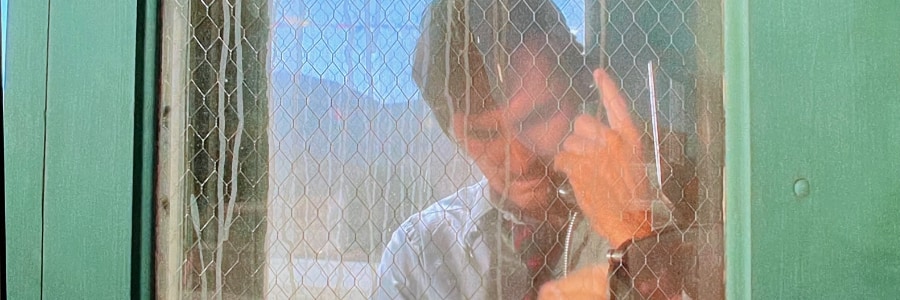
Duel (1971)
Director: Steven Spielberg
I watched Duel dozens of time on television as a kid, as well as it’s rip-off cousin The Car, so it was a treat to revisit it. I certainly didn’t notice our hero’s crisis of masculinity back then, but that’s one of the gifts of middle age, I guess.
David Mann is a salesman driving across the California desert to an appointment that he can’t be late for. He passes a truck, but it immediately overtakes him back as soon as he slows down. Mann is forced into more and more dangerous maneuvers to stay ahead of the truck and its driver, who he begins to realise is playing a deadly game.
George Miller must have been inspired a little by this when he was making Mad Max eight years later. The chase scenes are always exciting, even when they stretch for several minutes across a monotonous desert landscape, which is testament to Spielberg’s direction. It’s mind-boggling to think this was his first film. He was twenty-four ffs.

Director: Dan O’Bannon
While showing a new employee around a medical supplies warehouse, manager Frank accidentally cracks open a military canister containing a chemical that can bring dead bodies back to life. The leak infects a corpse in the freezer which they manage to dismember and cremate, but the contaminated smoke falls on a nearby graveyard.
This is a high energy, gory teen comedy, with plenty of slapstick moments, just like Evil Dead 2, but it’s more of an ensemble piece than that. The punks hanging out in the graveyard are everything I wish I’d been as a teen — vibrant, trashy, horny, loud, and sometimes naked in public. The downside is that there’s too much shouted dialogue in small rooms.
Hidden in the chaos is a tragic moment when an undead woman, tied to a table, is asked why she needs to eat people’s brains, and she says it’s the only thing that eases the pain of being dead. Which broke my heart a bit.
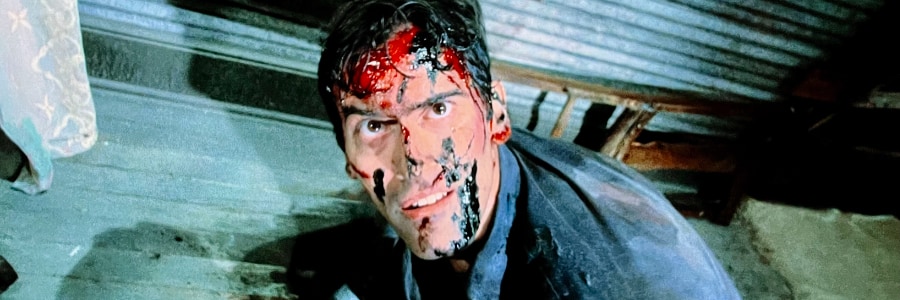
Evil Dead 2 (1987)
Director: Sam Raimi
In the role he is most famous for, Bruce Campbell tears up the screen as Ash, a man who wanted to have a romantic weekend in the woods with his girlfriend, Linda, and is instead made to fight for his life against demon-possessed corpses. And trees.
It starts with a recording of a missing archaeologist reading mysterious words from The Book of the Dead. This summons a demon who quickly possesses Linda. When the professor’s daughter, Henrietta, arrives looking for her father, instead she finds a half-mad Ash covered in blood, and her undead mother in the cellar.
It’s showing its age and budget constraints, but this is more than made up for by the charisma of the cast, Raimi’s creativity with the camera, and a relentless pace that doesn’t let up. Ash’s transformation from awkward nerd via slapstick comedy and self-mutilation to action hero is one of the wonders of the horror genre.